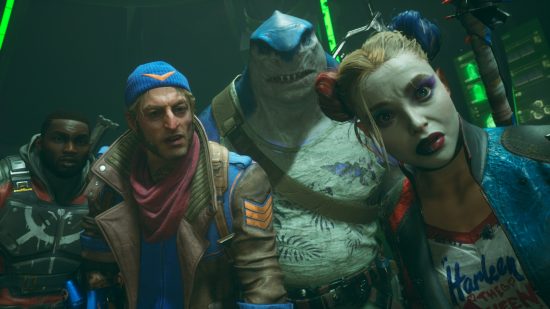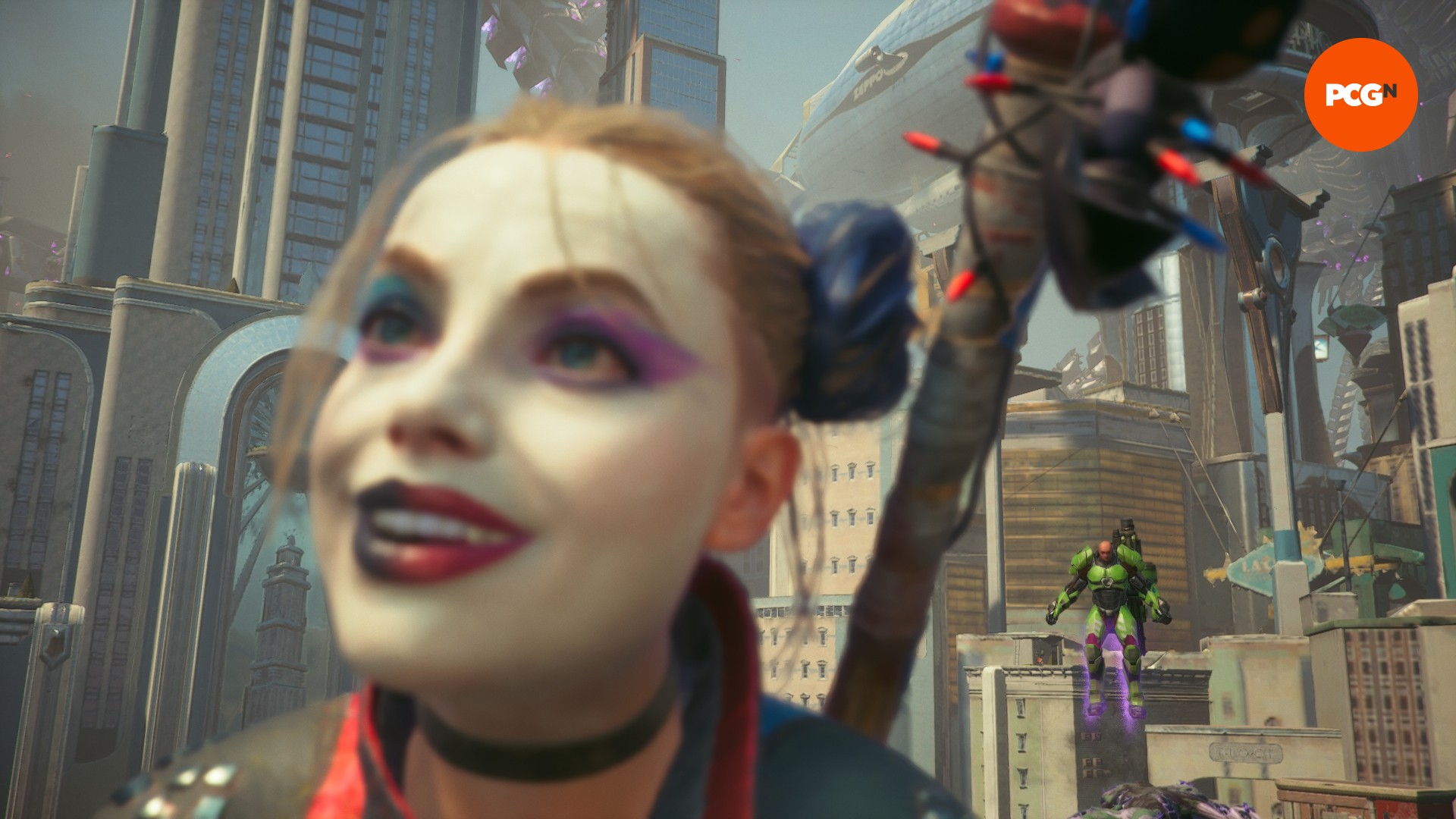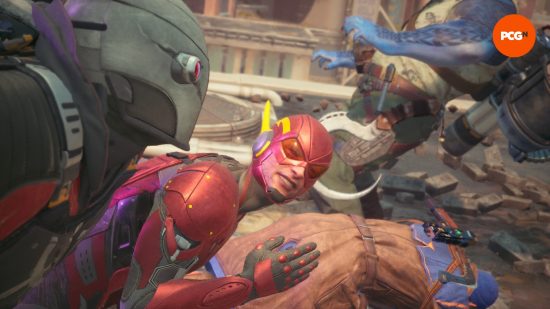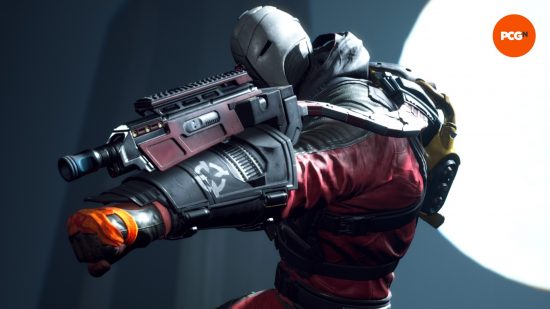Our Verdict
Suicide Squad: Kill the Justice League offers some fun, frantic action, but it gets lost in shallow, repetitive mission structures and frustrating narrative sensibilities.
You expect anything involving the Suicide Squad to be a little haphazard – especially an action-adventure game. The DC villains are forced to take on the missions nobody else wants in Suicide Squad Kill The Justice League, held captive by small bombs implanted in their brains by cunning black ops official Amanda Waller. They’re unwilling participants to the end, and that means controlling them can be challenging, especially when you’ve skill sets as varied as Harley Quinn and King Shark’s.
Even by the slapdash standards of the titular group, Suicide Squad: Kill the Justice League is too often the wrong kind of madcap. Brought in during an invasion from Brainiac, a cybernetic alien who’s managed to enslave the Justice League, the Suicide Squad – known in the superhero game as Task Force X – is thrown into a Metropolis in disarray, patrolled by waves of Brainiac’s henchman.
Harley, King Shark, Deadshot, and Boomerang are enlisted from the belly of Arkham Asylum and pushed into taking down Brainiac, whose giant metal skull leers over Superman’s home city. Ruthless and smart enough to understand they need each other for now, you bounce between them mission-to-mission, gathering tech, weapons, and information to pose a legitimate threat. Yet no matter how strong any of them get, you never fully get the sense these are actual supervillains.
Metropolis serves as an open sandbox, offering waypoint after waypoint. Waller and Colonel Rick Flag have missions that push the main story, while recognizable DC faces such as Poison Ivy and The Penguin offer sidequests for upgrades and XP. Besides the ensuing cutscenes and occasional boss battle, the busywork on offer is about the same.
You pick your leader, then jump in to fight countless assimilated goons, collecting color-coded pickups, and watching a satisfyingly large amount of numbers appear above enemy heads as you whale on them. Battles occur over a few waves of intensity, and once you win you’re given some loot, making more numbers go up.
Each of the four anti-villains offers a different playstyle on paper: Boomerang and Harley are quick and agile, using grappling hooks and the Speed Force to get around; King Shark blows through chunks of enemies using heavy artillery; and Deadshot is a tech-savvy sniper. But in practice, they converge into a broad scurry around the play area, avoiding damage and making kills.
I felt the difference in the first half of any encounter, where Brainiac’s entourage is more sparse. I could find a good vantage point as Deadshot, or swoop around being a nuisance as Boomerang. But usually by lap three or four, the intensity has gotten to the point where I’m running and gunning regardless of who I’ve chosen.
Encounters digress into numerous colored lasers magnetically honing in on your position from enemy snipers and other threats, while you scramble between them trying to collect the X quantity of loot that is required to progress. It verges on indecipherable, a malaise of brightly rendered attacks all pointed directly at you, while Flag or Waller command you to finish the job.
At points, Suicide Squad: Kill the Justice League gets remarkably close to the roguish charm of 2007’s Crackdown, where you dismantled the criminal underworld of a sci-fi utopia and, fuelled by bright orbs, become a genetic super agent by the end. Such exuberance, untethered from a need to be grim or dark, is truly refreshing now. But I fear we’re still a long way away from that kind of superhero storytelling becoming trendy.
In narrative missions, one of the mind-controlled superheroes usually shows up for a fight. These set-pieces are meant to be dramatic, underpinned by the good ones abandoning us, and the baddies knowing this is their shot to finally kill an adversary – but also not wanting to do it under these circumstances. The tension, however, is minimized by the preceding mindlessness.
These fights do have some flourish. Batman becomes a gigantic, flaming phantom, and you face Superman strapped to the nines in Kryptonite just hoping for the best. But they all become about shooting bullets into the target, then you’re right back to the same repetitive mission types. Cultural icons are toppled by a dude who’s good with a boomerang, a shark man, an assassin with some gadgets, and Harley Quinn, and it’s accepted all too quietly as the new normal.
Suicide Squad: Kill the Justice League is set in Rocksteady’s Arkhamverse, a sequel of sorts to the Batman Arkham trilogy. But there’s none of the finesse of those detective games, the clarity of vision and focus. Where those games were consistent, Suicide Squad is frayed and weightless, arcade-like in its propensity for swift blasts without too much commitment or concentration.

Reviewing on PC too, there were some irritating foibles. One update caused a temporary framerate lag, and bringing up any window caused distortion that required me to restart my session. I couldn’t alt-tab out, perhaps not the biggest problem if this was akin to Arkham Asylum, but this is meant to be played with a squad, so not being able to bring up Discord or another tool is troublesome.
It’s a pity, because the script is there, as are the performances. Tara Strong, Bumper Robinson, Samoa Joe, and Daniel Lapaine inject wit and conviction into our hapless heroes, bringing out their chemistry and deeper-than-you-might-think personalities. Kevin Conroy delivers one of his final turns as the Dark Knight, and Debra Wilson’s Amanda Waller is as commanding as you’d want. There’s an intriguing arc here, about four caricatures who begin to put value on their autonomy and role within the DC universe, that’s sidelined for rainbow collectibles and slingshotting around Metropolis.
Rocksteady made all the right moves for Clark Kent’s playground in contrast to Bruce Wayne’s. Large, bright, and overflowing in modern yet tasteful architecture, Metropolis seems like a place worth living in, unlike Gotham.
You can see the dedication and understanding of the source material. I applaud Rocksteady for taking a roundabout way into Superman’s world, avoiding the Man of Steel himself in favor of characters with more flaws and room for experimentation. Even as a fan of the last Kryptonian, I’m not sure I want an open-world game where he’s the star simply because of how boringly overpowered he is. Give me those who have to live in his presence, tell me about them, let me feel their morality – though in something where their personalities genuinely matter.
Some controversy swirled through Kill the Justice League’s development concerning live-service elements. Delays (it’s now nine years since Arkham Knight) suggested this was a less narrative-focused project that gradually got more single-player heavy due to backlash. The version that’s been released doesn’t hold much weight in either realm. It’s too disposably flashy to make me care, and too obsessed with cutscenes for the looting and shooting to seem rewarding.
I had fun at first. Then I started hoping Amanda Waller would trigger the bombs in these people’s heads. These might be the heroes Metropolis needs, but they’re not the heroes I want, and that’s saying something when one of them’s a muscly shark with a minigun.



